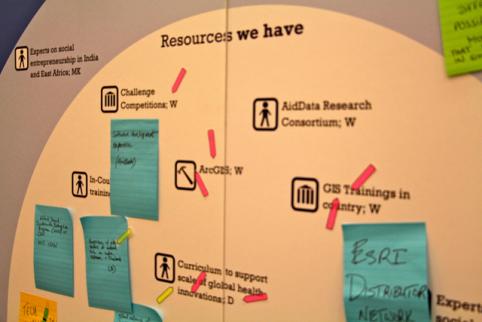Earlier this week, Taryn Davis recounted a number of victories achieved by the open data movement in 2013, including a growing consensus around the need for a data revolution. What should be the next chapter we write for the data revolution in 2014? The Guardian’s Zoe Smith recently pondered, “governments and donor agencies can release data, but if the power structures within which this data is consumed and acted upon do not shift, is there really any chance of significant social change?” Ms. Smith has hit upon an issue that is critical to the development effectiveness movement and something AidData has taken to heart.

Technical Manager Christian Peratsakis presents AidData 3.0 at the United States Agency for International Development.
In 2013, AidData released the third version of our development finance data portal so that government officials, policymakers and practitioners are better equipped to target, coordinate and evaluate development assistance. We began geocoding the universe of foreign aid in five countries with USAID’s Higher Education Solutions Network and continued to iterate new methodologies for capturing under-reported financial flows from emerging donors. Now that three governments - Haiti, Senegal, and Nepal - have publicly available, geocoded development finance data, will the release of this information change or influence the way these governments approach discussions of foreign aid?
Publicly available data - whether in the form of geocoded subnational data from Nepal or project-level information on development finance from an emerging donor like China – is critical to conversations about aid allocation and effectiveness. With that in mind, in the coming months, AidData will begin geocoding foreign aid in Indonesia, the Democratic Republic of the Congo and Honduras and announce improvements to our data and methodology on Chinese development finance in Africa. Integrating national budget information, private foundation flows and crowd-sourced feedback is also on our agenda for 2014.

If data is to influence decision-making in how we allocate, coordinate and evaluate foreign aid, we need more than stand alone maps, charts and dashboards. We need to not only identify what interesting data patterns and trends exist, but also to answer why. This week, approximately 70 scholars are participating in the inaugural convening of the AidData Research Consortium (ARC) with the intent to examine AidData’s georeferenced data, discuss new methods for analyzing spatial information and design pioneering research to answer pressing development questions in seven thematic areas. We look forward to bringing you new insights gleaned from these research initiatives throughout 2014 and beyond. In the meantime, stay tuned for tomorrow’s inside look at the AidData Research Consortium.
